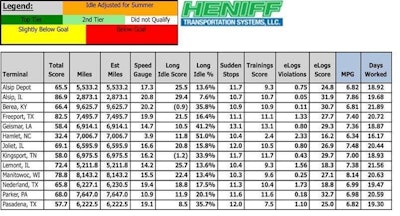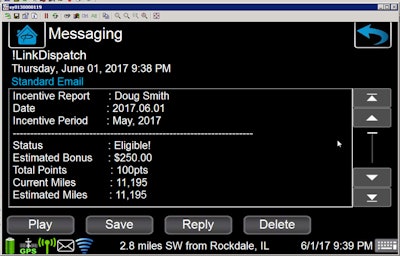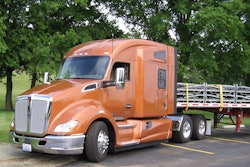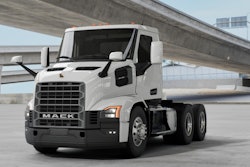 CLICK to enlarge. The custom driver scorecard of Heniff Transportation currently uses 13 metrics. Drivers that score above 85–currently about 75 percent of the fleet–receive a monthly bonus of $500.
CLICK to enlarge. The custom driver scorecard of Heniff Transportation currently uses 13 metrics. Drivers that score above 85–currently about 75 percent of the fleet–receive a monthly bonus of $500.Scorecards and incentive programs can engage drivers and deliver big returns in the high stakes business of trucking.
This was a takeaway from hearing Justin Neal, director of business integration at Heniff Transportation Systems, speak during a breakout session on Tuesday, August 15, at the 2017 PeopleNet and TMW in.sight user conference in Nashville.
The prior evening Heniff Transportation was recognized at a customer appreciation dinner by PeopleNet as an Innovator of the Year. The company developed a custom driver scorecard and incentive plan that helped to improve fuel economy by more than 20 percent, cut maintenance expenses and reduce turnover rates.
Heniff Transportation, based in Oak Brook, Ill., began to develop a scorecard in late 2012, Neal said. At the time the fleet operated approximately 250 trucks and fuel efficiency was its primary focus.
The fuel efficiency metrics came from the PeopleNet mobility system in its tractors. Drivers received a monthly check up to $400 for their efforts to save fuel.
“We wanted (the program) to pay for itself,” Neal said.
 Drivers at Heniff Transportation receive a daily message in the PeopleNet system with their scorecard details.
Drivers at Heniff Transportation receive a daily message in the PeopleNet system with their scorecard details.The evolution of the scorecard continued by using a data warehouse to pull data from its PeopleNet Link server and enterprise software system, TMW Suite, and then analyzing and visualizing metrics using Microsoft SSRS, Neal said.
All of its scorecard metrics have tabs that enable driver managers to view detailed information for each driver and “drill down to events,” he said.
New metrics and changes are made to the scorecard on a six-month cycle.
“It’s been a long road for us with a lot of evolutions,” Neal explained. “With all the new technology data is easier to get to than ever before.”
As shown in the top picture, one of the metrics is SpeedGauge. This data comes from the fleet’s SpeedGauge application and shows the points drivers earn for complying with posted speed limits. Drivers also have a metric for Trainings that shows the points they earned for completing assigned ITI ProTread modules.
The most recent metric added, which is not in the picture, shows drivers their points for utilizing the Tire Pass service at Loves Travel Centers. The decision to add this metric came after discovering tire failures were the number one cause of breakdowns, said Joe Neal, director of information technology.
More specifically, the tire failures were caused by low air pressure, he said.
 Justin Neal, director of business integration at Heniff Transport, during a presentation at the in.sight user conference.
Justin Neal, director of business integration at Heniff Transport, during a presentation at the in.sight user conference.Drivers pull into fuel lanes at Loves with the Tire Pass service. A tire technician inflates their tires to the proper pressure, records tread depth, inspects lights and other items. The Tire Pass inspection data is sent to Heniff’s maintenance software system, he explained.
To ensure the Tire Pass metric is accurate, the scorecard validates Tire Pass lanes were available and open for service at locations where drivers fueled, he said.
Every day, drivers see the details of their score from a message sent to the PeopleNet Tablet display in the cab. Drivers that obtain a monthly score of 85 or above (on a scale of 100) receive a check for $500. Approximately 75 percent of its drivers qualify for the bonus every month, Justin Neal said.
Heniff created a driver manager scorecard and bonus program as well. By holding managers accountable, they became engaged in helping drivers improve scores. “That took us to the next level,” he said. “A huge push for us was getting everybody engaged.”
Since starting the scorecard and incentive plan, Heniff Transportation has grown to 500 trucks. Justin Neal estimates the savings from the scorecard and bonus program are 8 times the expense of driver bonuses. “It is a program that really pays for itself,” he says.
Driver retention has proven to be another benefit. The data show turnover rates of more than 50 percent for drivers who are not getting the bonus. The turnover rate for drivers getting the bonus is less than 20 percent, he said.














